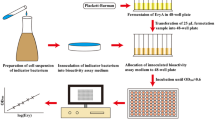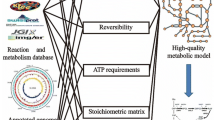Abstract
The heterologous biosynthesis of 6-deoxyerythronolide B (6dEB), a key intermediate in the biosynthesis of erythromycin, has recently been achieved in Escherichia coli, but the experimental product yield remains low. In this study, in silico strategies were adopted to evaluate and improve the biosynthesis of 6dEB in this strain. The theoretical capability of E. coli to produce 6dEB was first evaluated by analyzing the maximum theoretical molar yield (MTMY) of 6dEB utilizing three carbon sources, glucose, propionate and glycerol. Although propionate is presently most often used experimentally, our results indicated that glucose would be the most feasible substrate for 6dEB production from economic and long-term standpoints. Compared with Saccharomyces cerevisiae and Bacillus subtilis, E. coli was found to be a better heterologous host for the biosynthesis of 6dEB due to the higher MTMY value under the same conditions. Two strategies, including a flux distribution comparison analysis (FDCA) and linear minimization of metabolic adjustment based (LMOMA-based) methods, were proposed and employed for in silico strain improvement of 6dEB production, which yielded several potential gene targets for future experimental validation. In a further analysis, increasing the specific growth rate (SGR) or the non-growth associated maintenance (NGAM) was found to decrease the MTMY; while increasing the specific oxygen uptake rate (SOUR) or the specific carbon source uptake rate (SCUR) increased the MTMY. Taken together, our findings identified key factors directly affecting the MTMY of 6dEB production, which will guide future experimental research or even the industrial production of 6dEB.
Similar content being viewed by others
References
Wang, Y. and B. A. Pfeifer (2008) 6-deoxyerythronolide B production through chromosomal localization of the deoxyerythronolide B synthase genes in E. coli. Metab. Eng. 10: 33–38.
Zou, X., H. F. Hang, J. Chu, Y. P. Zhuang, and S. L. Zhang (2009) Enhancement of erythromycin A production with feeding available nitrogen sources in erythromycin biosynthesis phase. Bioresour. Technol. 100: 3358–3365.
Pfeifer, B., Z. Hu, P. Licari, and C. Khosla (2002) Process and metabolic strategies for improved production of Escherichia coli-derived 6-deoxyerythronolide B. Appl. Environ. Microbiol. 68: 3287–3292.
Pfeifer, B. A., S. J. Admiraal, H. Gramajo, D. E. Cane, and C. Khosla (2001) Biosynthesis of complex polyketides in a metabolically engineered strain of E. coli. Sci. 291: 1790–1792.
Pfeifer, B. A. and C. Khosla (2001) Biosynthesis of polyketides in heterologous hosts. Microbiol. Mol. Biol. Rev. 65: 106–118.
Wang, Y., B. A. Boghigian, and B. A. Pfeifer (2007) Improving heterologous polyketide production in Escherichia coli by overexpression of an S-adenosylmethionine synthetase gene. Appl. Microbiol. Biotechnol. 77: 367–373.
Gonzalez-Lergier, J., L. J. Broadbelt, and V. Hatzimanikatis (2006) Analysis of the maximum theoretical yield for the synthesis of erythromycin precursors in Escherichia coli. Biotechnol. Bioeng. 95: 638–644.
Feist, A. M., C. S. Henry, J. L. Reed, M. Krummenacker, A. R. Joyce, P. D. Karp, L. J. Broadbelt, V. Hatzimanikatis, and B. O. Palsson (2007) A genome-scale metabolic reconstruction for Escherichia coli K-12 MG1655 that accounts for 1260 ORFs and thermodynamic information. Mol. Syst. Biol. 3: 121.
Lee, J. M., E. P. Gianchandani, and J. A. Papin (2006) Flux balance analysis in the era of metabolomics. Brief Bioinform. 7: 140–150.
Yoon, S. H., Y. M. Lee, J. E. Kim, S. H. Lee, J. H. Lee, J. Y. Kim, K. H. Jung, Y. C. Shin, J. D. Keasling, and S. W. Kim (2006) Enhanced lycopene production in Escherichia coli engineered to synthesize isopentenyl diphosphate and dimethylallyl diphosphate from mevalonate. Biotechnol. Bioeng. 94: 1025–1032.
Price, N. D., J. A. Papin, C. H. Schilling, and B. O. Palsson (2003) Genome-scale microbial in silico models: The constraints-based approach. Trends Biotechnol. 21: 162–169.
Varmar, A. and B. O. Palsson (1993) Metabolic capabilities of Escherichia-coli: II Optimal-growth patterns. J. Theor. Biol. 165: 503–522.
Varmar, A. and B. O. Palsson (1993) Metabolic capabilities of Escherichia coli: I. synthesis of biosynthetic precursors and cofactors. J. Theor. Biol. 165: 477–502.
Reed, J. L., T. D. Vo, C. H. Schilling, and B. O. Palsson (2003) An expanded genome-scale model of Escherichia coli K-12 (iJR904 GSM/GPR). Genome Biol. 4: 54.
Alper, H., K. Miyaoku, and G. Stephanopoulos (2005) Construction of lycopene-overproducing E. coli strains by combining systematic and combinatorial gene knockout targets. Nat. Biotechnol. 23: 612–616.
Alper, H. and G. Stephanopoulos (2008) Uncovering the gene knockout landscape for improved lycopene production in E. coli. Appl. Microbiol. Biotechnol. 78: 801–810.
Jin, Y. S. and G. Stephanopoulos (2007) Multi-dimensional gene target search for improving lycopene biosynthesis in Escherichia coli. Metab. Eng. 9: 337–347.
Lee, K. H., J. H. Park, T. Y. Kim, H. U. Kim, and S. Y. Lee (2007) Systems metabolic engineering of Escherichia coli for Lthreonine production. Mol. Syst. Biol. 3: 149.
Lee, S. J., D. Y. Lee, T. Y. Kim, B. H. Kim, J. Lee, and S. Y. Lee (2005) Metabolic engineering of Escherichia coli for enhanced production of succinic acid, based on genome comparison and in silico gene knockout simulation. Appl. Environ. Microbiol. 71: 7880–7887.
Becker, S. A., A. M. Feist, M. L. Mo, G. Hannum, B. O. Palsson, and M. J. Herrgard (2007) Quantitative prediction of cellular metabolism with constraint-based models: The COBRA Toolbox. Nat. Protoc. 2: 727–738.
Segre, D., D. Vitkup, and G. M. Church (2002) Analysis of optimality in natural and perturbed metabolic networks. Proc. Natl. Acad. Sci. USA 99: 15112–15117.
Boghigian, B. A., K. Lee, and B. A. Pfeifer (2009) Computational analysis of phenotypic space in heterologous polyketide biosynthesis—applications to Escherichia coli, Bacillus subtilis, and Saccharomyces cerevisiae. J. Theor. Biol. 262: 197–207.
Shiba, Y., E. M. Paradise, J. Kirby, D. K. Ro, and J. D. Keasling (2007) Engineering of the pyruvate dehydrogenase bypass in Saccharomyces cerevisiae for high-level production of isoprenoids. Metab. Eng. 9: 160–168.
Herrgard, M. J., N. Swainston, P. Dobson, W. B. Dunn, K. Y. Arga, M. Arvas, N. Bluthgen, S. Borger, R. Costenoble, M. Heinemann, M. Hucka, N. Le Novere, P. Li, W. Liebermeister, M. L. Mo, A. P. Oliveira, D. Petranovic, S. Pettifer, E. Simeonidis, K. Smallbone, I. Spasic, D. Weichart, R. Brent, D. S. Broomhead, H. V. Westerhoff, B. Kirdar, M. Penttila, E. Klipp, B. O. Palsson, U. Sauer, S. G. Oliver, P. Mendes, J. Nielsen, and D. B. Kell (2008) A consensus yeast metabolic network reconstruction obtained from a community approach to systems biology. Nat. Biotechnol. 26: 1155–1160.
Oh, Y. K., B. O. Palsson, S. M. Park, C. H. Schilling, and R. Mahadevan (2007) Genome-scale reconstruction of metabolic network in Bacillus subtilis based on high-throughput phenotyping and gene essentiality data. J. Biol.Chem. 282: 28791–28799.
Author information
Authors and Affiliations
Corresponding author
Additional information
First two authors contributed equally to this work.
Rights and permissions
About this article
Cite this article
Meng, H., Lu, Z., Wang, Y. et al. In silico improvement of heterologous biosynthesis of erythromycin precursor 6-deoxyerythronolide B in Escherichia coli . Biotechnol Bioproc E 16, 445–456 (2011). https://doi.org/10.1007/s12257-010-0321-7
Received:
Revised:
Accepted:
Published:
Issue Date:
DOI: https://doi.org/10.1007/s12257-010-0321-7




